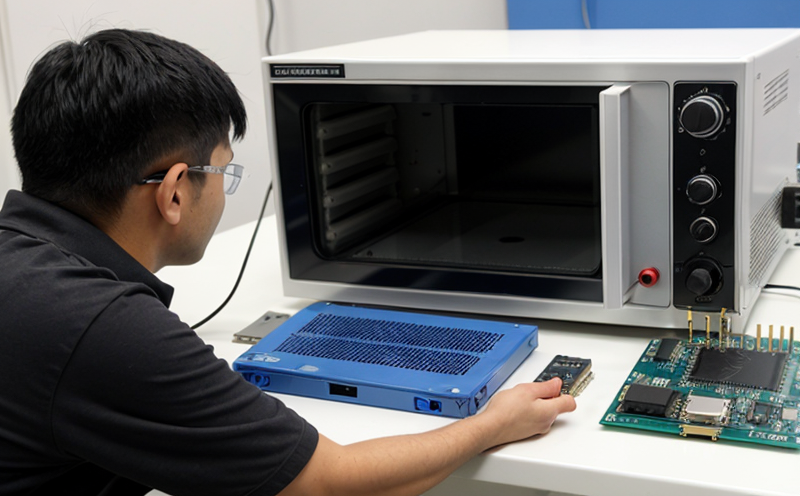DIN EN 60068 Environmental Testing for Microelectronic Parts
The DIN EN 60068 series of standards is widely recognized and utilized in the electronics testing sector. This comprehensive environmental stress testing protocol evaluates microelectronic parts' robustness under a range of extreme conditions, ensuring their reliability across diverse operational environments.
Microelectronics are integral to modern technology, powering everything from consumer electronics to critical infrastructure systems. Ensuring these components can withstand various environmental stresses is paramount for product safety and longevity. DIN EN 60068 provides standardized test methods that assess the durability of microelectronic parts under conditions such as high and low temperatures, humidity, vibration, and more.
The standards encompass a variety of tests including temperature cycling (temperature shock), thermal shock, and high/low temperature storage. These tests are critical for ensuring microelectronics can perform reliably in harsh environments without failure or degradation. For instance, components used in aerospace applications must meet stringent environmental requirements to ensure they operate flawlessly under extreme temperatures and pressures.
The methodology involves subjecting the test specimens to controlled conditions that simulate real-world stresses. This process is designed to identify any weaknesses or potential failures in the design of the microelectronic parts before they are deployed into operational use. By adhering to DIN EN 60068, manufacturers can ensure their products meet international quality and safety standards.
The testing procedure typically involves precise control over environmental variables such as temperature, humidity, and vibration. Specimens must be accurately prepared for the tests, ensuring they represent the intended end-use environment. Instruments used in these tests include climate chambers capable of simulating various temperature extremes, humidity cabinets, and shakers designed to replicate vibrational forces.
The results from DIN EN 60068 testing are critical for quality managers and compliance officers as they provide verifiable data on the environmental robustness of microelectronic parts. This information is essential for R&D engineers in refining product designs, improving reliability, and ensuring regulatory compliance. For procurement teams, these test results help in selecting suppliers who meet stringent environmental stress criteria.
By adhering to DIN EN 60068 standards, manufacturers can ensure their products are reliable under a wide range of conditions, enhancing market trust and customer satisfaction. This standard plays a crucial role in the electronics testing sector by providing a robust framework for evaluating microelectronic parts' environmental resilience.
Scope and Methodology
The scope of DIN EN 60068 encompasses various aspects of environmental stress testing for electrical, electronic, and mechanical products. The standards are designed to ensure that these components can withstand the rigors of real-world conditions without failure. For microelectronic parts specifically, the focus is on assessing their performance under extreme temperature variations, humidity levels, and other environmental stresses.
The methodology involves subjecting specimens to controlled environmental conditions in a climate chamber or similar facility. Temperature cycling tests, for instance, expose samples to rapid changes between high and low temperatures, simulating the operational environment they might encounter. This process helps identify any thermal shock effects that could compromise the integrity of the microelectronic parts.
Humidity testing is another critical component of DIN EN 60068. Specimens are exposed to high humidity levels over extended periods to assess their resistance to moisture-related damage, such as corrosion or insulation degradation. Vibration tests further simulate the mechanical stresses that components might endure during transportation and use.
- Temperature cycling (temperature shock)
- Thermal shock
- High/low temperature storage
- Vibration testing
- Humidity testing
The acceptance criteria for these tests are based on the standards' requirements and include specific parameters such as maximum allowable changes in electrical resistance or mechanical integrity. Compliance with these criteria ensures that microelectronic parts meet the required levels of environmental robustness.
Eurolab Advantages
At Eurolab, we offer unparalleled expertise and cutting-edge facilities for DIN EN 60068 testing. Our team of experienced professionals ensures that every test is conducted with precision and accuracy, providing clients with reliable data they can trust.
- Dedicated climate chambers capable of simulating extreme environmental conditions
- State-of-the-art vibration testing equipment to replicate real-world mechanical stresses
- Comprehensive reporting services that provide detailed analysis and recommendations
- ISO/IEC 17025 accreditation ensuring the highest standards of quality and reliability
We work closely with our clients to understand their specific needs and tailor testing protocols accordingly. Our commitment to excellence ensures that every test is conducted in compliance with international standards, providing a robust foundation for product development and compliance.
Environmental and Sustainability Contributions
- Reduces waste by ensuring products are designed for durability and reliability
- Promotes the use of sustainable materials through informed design decisions
- Enhances product lifecycle management by identifying potential failure points early in development
- Supports regulatory compliance, reducing the risk of fines or recalls
DIN EN 60068 plays a crucial role in promoting environmental sustainability within the electronics sector. By ensuring microelectronic parts are robust and reliable, it reduces the need for frequent replacements, thereby minimizing electronic waste. The standard also encourages the use of sustainable materials that can withstand harsh conditions without degradation. This not only extends the lifecycle of products but also supports broader sustainability goals by reducing resource consumption.
By identifying potential failure points early in the design process, DIN EN 60068 helps manufacturers make informed decisions about material selection and component design. This approach minimizes unnecessary use of resources and contributes to a more sustainable production process. Compliance with these standards also ensures that products meet regulatory requirements, reducing the risk of environmental impact through non-compliant practices.





